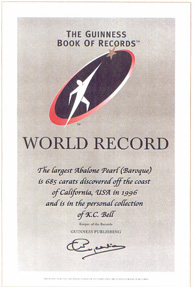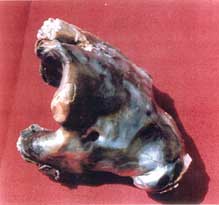Although Abalone produces natural pearls they are rare. Statistical
research indicates that a fine large pearl over 15mm is found in a
low estimate of one per five hundred thousand to a more probable estimate
of one pearl per nine hundred thousand animals. Reasons for rarity
are that large pearls require approximately eight to ten years to
form. Since animals are fished commercially for meat when they are
four or five years old sufficient time has not allowed pearl formation.
Also, not all Abalone produce pearls. A specific combination of factors
must exist for natural pearl formation. For example:invasion of a
foreign object,usually a living parasite, sufficient movement of the
animal, correct immune system response, correct water temperature,
and availability of correct diet.
Natural Abalone pearls can vary in shape,
color, and may be solid or hollow. Natural pearl shapes can vary from
round or ovalish to flat baroques to giant horn shapes. Colors range
from royal blues and greens to magentas and silver pinks to gold and
bronze to silver and cremes and purples often times in brilliant combinations.
Several pearls of different colors and shapes can be found in a single
animal. Natural Abalone pearls are formed in thick nacreous layers
joined together by organic conchiolin. This form is similar to the
Oriental Pearl formation except that the nacreous layers are thicker. Natural Abalone Pearls can be utilized in all types of jewelry and
in rare instances pairs can be matched up and over time en suite sets
can be painstakingly collected.
Abalone is the only mollusk that can be used commercially one hundred
percent: its shell for inlay and buttons and carvings, its meat for
food, its guts for fishing bait, and most importantly its rare natural
pearls which are formed freely within the animal.
Perhaps the most interesting of the abalone fisheries is that on the shores of Quel Island, about sixty miles south of the Korean coast, which is inhabited largely by women. Dressed only in a scanty garment, these women swim out to the fishing grounds,distant several hundred yards in some cases, carrying with them a stout knife and a small sack suspended from a gourd. On reaching the reefs, they dive to the bottom,sometimes to a depth of six to eight fathoms. and by means of the knife, remove the abalones and place them in the sack. They may remain out for an hour, diving repeatedly until the sack is filled, when they swim back to the shore.Pearls are found only rarely; in one lot of one hundred shells, only five were found to contain pearls; two with three pearls each; two with two pearls each and one with a single pearl.
The flesh of the mollusk after it has been cleaned and dried, is quite popular to eat and once pounded out and quickly cooked, it is very delicious.
Top
Back to Stones 3
San Francisco Peace and Love Music Table of Contents Home


